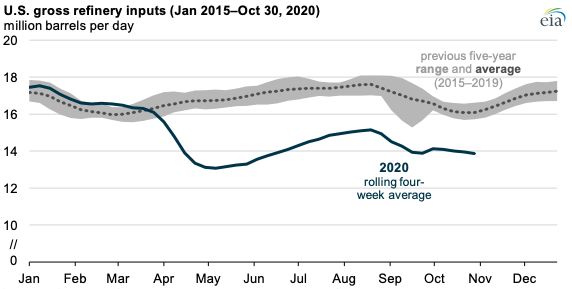Since April, when responses to the 2019 novel coronavirus disease (COVID-19) reduced demand for refined products such as gasoline, distillate fuel, and jet fuel, gross inputs of crude oil and other raw materials to U.S. refineries (refinery runs) have been lower than the five-year range (2015–19). Although runs have increased compared with their April lows, the continued effects of the pandemic, in addition to seasonal factors, have resulted in continued lower refinery runs. As of October 30, U.S. refinery runs were 14.0 million barrels per day (b/d), or about 13% lower than the average for this time of year, according to the U.S. Energy Information Administration’s (EIA) Weekly Petroleum Status Report.

In April, substantial declines in U.S. domestic demand for petroleum fuels resulted in a significant reduction in U.S. refinery operations. Beginning in June, some refiners began increasing their refinery runs in response to gradual increases in demand, particularly for gasoline. By the week ending August 21, gross inputs to refineries reached 15.3 million b/d, the highest level since April.
The Gulf Coast is the largest refining region in the country and has been affected by a particularly active storm season this year. The Gulf Coast region is the source of most U.S. petroleum exports and is more likely to be affected by less global demand for petroleum fuels.
East Coast refiners have experienced the largest decline in runs from the five-year average in percentage terms. EIA attributes much of the change in East Coast refining to the closure of Philadelphia Energy Solutions in June 2019, the region’s largest refinery.
The Midwest is the only U.S. region where refinery runs have been higher than the previous five-year average since April. Refinery runs in the Midwest likely increased because of greater agriculture sector demand from this fall’s harvest.
More information on U.S. refining markets is available in EIA’s This Week in Petroleum.
Principal contributor: Kevin Hack








